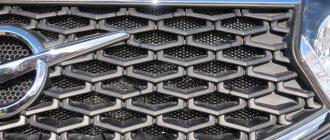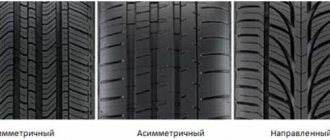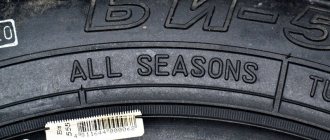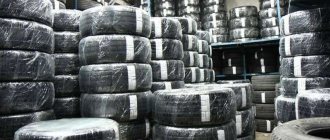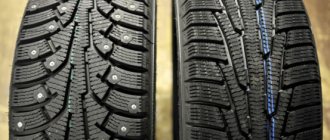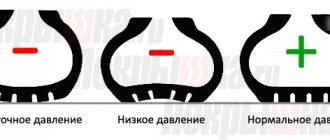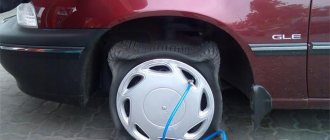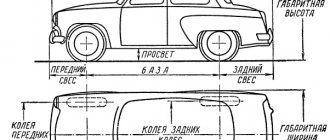Are you looking for what the M+S marking on car tires means? In this article you will learn how M+S is deciphered on tires and how to operate tires with this marking.
There are two general tire classification systems that help determine the traction characteristics of winter tires. All tires that have passed certain winter traction tests may be marked with a symbol on the sidewall of the tire. One is the M+S symbol (mud and snow) and the second is the mountain/snowflake symbol (3PMSF) . Both are based on standardized tire industry testing, however the degree of testing and grip levels required to qualify each symbol are very different.
While both symbols are useful indicators of what you can expect from a tire, it is important to understand the difference between them. This is especially important when choosing tires for your car, SUV or light truck in cold climates.
Each winter tire is marked M+S. It is also found on some summer tires, which many drivers classify as all-season tires. However, this is not entirely correct. For example, most car tires for SUVs or tires intended for sale in the American market are labeled M+C, but do not always meet the needs of drivers in winter conditions.
Let's look at what M+S on tires actually means.
What does M+S on rubber stand for?
M+S is an abbreviation for Mud+Snow, which literally translates from English as “mud + snow.” With this marking, the manufacturer informs the consumer that the tire provides better traction on mud and snow than a regular summer tire. But this does not mean that it meets the requirements for winter tires and can be used safely in winter.
Properties of rubber . The letters MS on the sidewall of the tires also indicate stronger grip on the road due to the use of softer rubber in the production; this factor minimizes such an unpleasant phenomenon as aquaplaning (full or partial separation of the wheel from the road surface). The level of rolling resistance also increases, providing more comfortable conditions during the trip.
There is only one small nuance: the MS designation, unfortunately, is not a symbol protected by law (any manufacturer can put it on the tire, next to the standard size, speed and load indices). So, the promised improved driving performance in snow and mud, which the ms marker denotes, may turn out to be only a “publicity stunt”. However, famous brands (Nokian, Bridgestone, Yokohama and other manufacturers who value their reputation) are responsible for each symbol indicating certain qualities of the tire and applied to its surface.
The specific rubber tread pattern marked MS allows them to move more confidently on snowy and wet roads, as well as cover significant distances off-road without any problems.
What does the MS marking on car tires mean?
The use of a certain type of tires, depending on the operating conditions of the vehicle, guarantees the comfort and safety of vehicle movement. You can choose the right tires by reading the decoding of the designation applied by tire manufacturers to the side of the product. In this article we will figure out what the MS marking on rubber means.
Seasonality of tires
The MS designation on rubber is deciphered as follows:
- M - indicates the word “Mud”, translated meaning dirt;
- S is the first letter of the word "Snow", meaning snow.
Accordingly, MS on rubber indicates the possibility of using tires in slush, mud, and snowy weather. This marking was introduced by tire manufacturers. With its help, manufacturers designate all-season tires.
This marking is used for all-season tires and SUV tires. Please note: not all tires with this letter designation are suitable for use in harsh winters. The only sign indicating that a tire meets winter characteristics is an image of snowflakes inside a mountain (see Figure 1).
Figure 1. Winter tire sign.
The indicated image indicates that the product meets the requirements of the Canadian Rubber Manufacturers Association and the US Rubber Manufacturers Association. Tires that have a snowflake mark on the side surface are considered winter tires.
All-season tires marked with MS are considered by car enthusiasts to be a kind of compromise between summer and winter tires. Please note: all-season tires do not provide an adequate level of safety at ambient temperatures below -5 0C. In severe winter conditions, all-season products are replaced with tires designed for winter use. A tire with MS markings and a winter sign on the side surface provides a high level of safety on snowy roads. Has the following advantages:
- the product is made from rubber raw materials adapted to low temperatures;
- a special tread layer allows you to avoid skidding on road surfaces covered with ice or snow;
- increased lamellaization, allows you to drive through snowdrifts.
We recommend watching a video about the advantages and disadvantages of tires with the MS designation on the side of the tire:
Advantages and disadvantages of all-season tires
The MS marking on the tires indicates that the tires are all-season. Such rubber can be used all year round, provided that the range of changes in ambient temperature corresponds to the temperature of use of all-season tires. Let's figure out what the advantages and disadvantages of these products are.
Tire marked M+S.
The tread pattern of all-season tires is significantly lower than the tread of products used only in winter. Tires with such a tread layer are suitable for use in regions where the air temperature in winter does not drop below -5 0C. The tread layer blocks are separated by special lamellas; such design features help to avoid skidding when driving on a snowy surface. All-season tires have satisfactory characteristics for their use in summer in regions where the air temperature is not too high.
We recommend: Removing the radiator grill on Renault Duster: two methods + video
Advantages of products with the MS mark:
- there is no need to replace tires when the season changes;
- the specified tires are equal in price to summer tires, they are much cheaper than winter tires, they can be used on snowy surfaces at temperatures not lower than -5 0C;
- during the demi-season, you do not need to worry about replacing tires;
- there is no need to purchase two sets of tires (for winter and summer), and also to provide them with proper storage conditions.
Flaws:
- all-season tires wear out 15% faster than summer tires and require frequent replacement;
- the specified tires do not provide the proper level of safety at too high (low) temperatures;
- tires are designed for measured driving; they are not suitable for those who like to drive fast;
- when the temperature is below -5 0C, the specified tires become “tanned”, driving comfort and safety are reduced;
- have excessive elasticity at very high temperatures;
- They are inferior to winter tires in terms of the level of grip of tires on ice and snow.
The conclusion suggests itself: tires with the MS marking on the side surface without a winter sign are worth buying for a warm winter or the mid-season period. These products are suitable for drivers who prefer a measured driving style.
The MS designation on the rubber indicates that the tires are all-season, and tires for SUVs also have this marking. A winter sign may or may not be present near the indicated marking. In the first option, tires cannot be used at too low temperatures: they will not be able to provide the required level of safety and there is a risk of skidding. In the second case, tires can be considered winter; they provide the necessary grip on snowy or icy road surfaces even in severe winter conditions.
Seasonality of M+S tires
About 70% of car enthusiasts mistakenly believe that the MS marking usually refers exclusively to winter tires. This opinion may cause disappointment in purchasing this product, since what this marker means for a specific brand of tire is known only to its manufacturer.
In principle, initially this class of tires was aimed at operation in Europe, the climatic conditions of which are different from the conditions of Russian winters, and therefore its use as a set of tires for our cold season is possible only in two cases:
- Advanced Features . A 100% guarantee that the purchased tires can really be classified as winter tires is provided only by the presence next to the MS symbol of an additional sign in the shape of a snowflake (with a mountain in the background). This is exactly what ms winter tires mean, which means that they have been tested in conditions as close as possible to the Russian climate and have received approval from the Association of Manufacturers of the USA and Canada (authoritative organizations that place high demands on automobile tires).
- Operation in a metropolis . Roads in large cities of the Russian Federation in winter are not much different from European highways (the same slush, dirt, lack of an ice layer - thanks to the reagents), and therefore in these megacities it is quite possible to drive on MS tires even in cold weather. Despite the fact that the MS marking means improved tire performance when driving in both snow and mud - this is more likely to save the car enthusiast in the off-season, and not in the harsh winter (the class of all-season tires suits them more).
Pros and cons of all-season tires
The advantages of a product with m tire markings are quite obvious:
- no need to buy a second set of tires;
- a more developed tread allows you to move off the road;
- unlike seasonal tires, they can provide acceptable traction of the car with the road throughout the year;
- increasing the comfort of movement by changing the rubber composition.
However, m+s tires have several disadvantages that prevent them from being a truly universal solution for all occasions:
- The first and main complaint is that rubber shows its best performance at temperatures around zero. The quality of the composition does not allow it to compete with specialized seasonal products. All-terrain wheels can only be used in spring or autumn;
- The marking means an improved tread and a different rubber compound that provides good traction on dirt. But you shouldn’t always rely on such wheels - when driving in the most impassable thickets, you should take a special off-road kit.
What is the difference between M+S and a snowflake - 3PMSF
Recognizing the need for a more relevant and useful measurement of true winter performance, as well as a way to differentiate all-season tires from winter tires. The Rubber Manufacturers Association (RMA) came up with the "Mountain/Snowflake" symbol - 3PMSF for winter tires. When you see this badge on the sidewall of the tire, you can be sure that it meets the more stringent winter traction requirements and has been rated as "heavy snow." This includes snowy, slippery and cold or freezing roads.
You can learn more about what 3PMSF means in this article.
Most all-season tires do not meet the "Mountain/Snowflake" symbol because the tread rubber on all-season and summer tires becomes hard at temperatures below 40°F. Only specially designed winter tires, select all-terrain light truck tires and SUV tires, and some of the "all-season tires" The latest generation meets the traction performance requirements of the strict snow rating for the Mountain/Snowflake symbol. One all-season tire with a mountain/snowflake symbol is the Nokian WR G3 Tire. Nokian WR G3 are tires that you can leave on your car all year round and still be sure of good traction.
Maximum safety on winter roads is ensured only by winter tires that have a generally recognized marking - a three-peak mountain with a snowflake. To obtain it, the tire must exceed an acceptable threshold for the “snow grip index” and guarantee the minimum required performance in winter conditions (which are regulated by the relevant regulations on “vehicle safety”).
Such tests are carried out by tire manufacturers themselves or third-party companies, based on the results of which a tire can be recognized as a winter tire, undergo certification and be allowed for sale.
In turn, for a tire to receive the M+S marking there are no requirements for its performance in winter conditions. A tire only needs to have good traction on snow and mud, but this does not say anything about its reliability of traction on ice, snow and asphalt at low temperatures. Formally, at temperatures below 7 degrees, the M+S tire works the same as any summer tire.
The M+S marking is applied to the following tire manufacturers:
Amtel, Barum, Bridgestone, Continental, Cooper, Cordiant, Dayton, Debica, Goodyear, Dunlop, Falken, Firestone, Fulda, General, Gislaved, Hankook, Kama, Kelly, Kleber, Kormoran, Kumho, Marshal, Matador, Maxxis, Michelin, Nitto, Nokian, Pirelli, Sava, Semperit, Tigar, Triangle, Toyo, Uniroyal, Yokohama, Rosava, Belshina.
Eventually:
The M+S marking indicates that the tire provides more traction in mud and snow than regular summer tires and is not necessarily safe for use in winter conditions.
Table of ms tires from manufacturers
| Manufacturer | Disk size | Cost, rub. |
| Dunlop Grandtrek ST20 | 16-18 | 360-10330 |
| Dunlop SP Sport 2030 | 15-18 | 370-5710 |
| Kumho Ecsta STX KL-12 | 16-22 | 370-13920 |
| Kumho Road Venture APT KL51 | 15-20 | 360-12010 |
| Kama 204-205 | 12-14 | 1690-1870 |
| Cordiant Business CA | 14-16 | 2850-5220 |
| Yokohama SuperVan Y354 | 14-16 | 4070-8380 |
| Goodyear Wrangler HP All weather | 15-19 | 4130-12000 |
| Michelin CrossClimate plus | 15-18 | 4190-13760 |
| Yokohama Geolandar A/T G015 | 15-18 | 4220-14400 |
| Continental Vanco Four Season | 16-18 | 4490-11117 |
| Hankook Radial RA10 | 15-16 | 4510-6550 |
American tire markings
American designations
In the United States, passenger car tires are labeled differently than in Europe and the post-Soviet countries.
For example, it may look like: 30 x 9.5R 16 LT
It can be decrypted as follows:
- 30 — external size (wheel diameter in inches);
- 9,5 — tire width (also in inches);
- R - radial intersection of cord threads;
- 16 — internal diameter (in inches);
- LT – what kind of transport is it suitable for? In this case, it is a commercial vehicle (LightTruck).
This is interesting: What is the shelf life of winter tires?
What are the tire markings?
All the markings that manufacturers place on car tires can be divided into several categories. The first is mandatory markings. These include the tire's production date, its size, speed index, and load index. The second category is markings that manufacturers place at will. For example, indices of rubber compound hardness, wear resistance and temperature conditions. And there are markings, the right to place which still needs to be earned. These include the marking three-peak mountain snowflake (3PMSF), or “three mountain peaks and a snowflake inscribed in them.”
How to choose tires wisely
When choosing tires for the cold season, you should be guided not only by the Rules of the Road, but also by common sense. In Belarus, winter is cold, with ice and snow, so tires must be suitable for the weather. And these will be tires labeled “three mountain peaks and a snowflake”, because they have proven their effectiveness in winter tests. The same markings are found not only on real winter tires, but also on real “all-season” tires. Read more about safe all-season tires here.
Dry residue according to markings
When purchasing a tire, you need to carefully study its characteristics, manufacturer's recommendations and, preferably, tire tests.
MS marking does not mean at all that the tire will behave confidently on snow, much less on ice. Just like the 3PMSF (Three Peak Mountain Snow Flake) badge, that is, “mountains and snowflake,” does not guarantee that the tire is suitable for the climatic conditions in your area. When purchasing a tire, you need to carefully study its characteristics, manufacturer’s recommendations and, preferably, tire tests. Then your shoes will be appropriate for the weather, and the trip will be safer.
Summer tires
The term “summer tires” is a bit strange in principle. Since all tires could initially be classified as this type, regardless of their size. The term was not invented separately. The composition of the rubber is quite hard. This means that hot asphalt is not scary for her.
Here we also do not forget about the friction of rubber on the road surface, which leads to even higher temperatures.
Now let's take the tread pattern. Roughly speaking, it is “blurred”. Let us explain, when the rubber comes into contact with the road, the tread plays an important role - it is a certain number of longitudinal, slightly oblique lines. Between these lines there are drainage grooves of sufficient length and smoothness.
The direction of the grooves will necessarily be forward and sideways. It is not difficult to explain this decision of the manufacturers. Because the fluid must come out as quickly as possible due to the pressure of the wheel underneath it. And the liquid is squeezed out until it gets under the wheel.
If the water layer is severe enough, or there are problems with drainage, the situation on the road can become dangerous. Because this is where the term “aquaplaning” comes into play. That is, the wheel floats on liquid. Because the protector did not have time to remove it in time.

